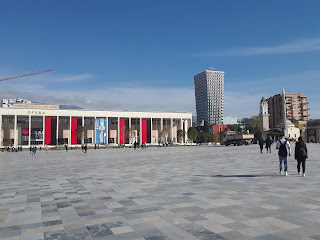Albania: The History
 |
| Skandenbeg Square, Tirana, Albania |
We did get lost several times because the streets wind, diverge, and then connect. Sometimes there are street signs, sometimes there is nothing. There are no numbered street addresses (like 12677 Beadle Lake Road); instead they go by landmarks. When we called from the airport to meet up with our landlords, they told us to go to the Select Hotel and Bar; they would meet us there and take us to the apartment. Because there is no address. It reminds me of Cuba - locals know where everything is and if you are new, they'll show you. Just another example of the idea of community - you cannot survive life unless you depend and extend the help to others.
 |
| Men outside the National Historical Museum of Albania |
It was in that square that we found the National Historical Museum - entirely by accident. I was just drawn to the mural on the front. While the museum had some positively draconian rules about photographs, we still were able to learn so much about Albania.
The mural at the front of the museum is called "The Albanians"; from left to right, it shows the different eras of Albania: from prehistory and the Illyrians to the partisans and communist. But there in the middle is Albania herself - always moving forward.
During the Iron and Bronze Ages, the Illyrians traded with their neighbors to the south - the Greeks - and the Etruscans to the west - early Italians. Cultures intermingled. Some Illyrian tribes/polis adopted the gods and goddesses of Greece (like Apollo) but really who knows in which direction the cultural exchange happened.
When Rome developed, the Illyrians were a threat because they also traded on the Adriatic Sea (remember, when in doubt, the answer is trade). It didn't help that the Illyrian Queen Teuta ordered the execution of a Roman envoy. After three bouts of war, Illyria became a Roman province.
And yet, when Rome fell, Albania continued.
During the Middle Ages, the Ottoman Empire was expanding into Europe. And one place that they wanted was Albania. The great Skandenbeg, an Albanian prince, brought together all the princes of Albania and lead a resistance against the Ottomans. See the Ottomans had taken over Albania during his father's reign. Skandenbeg was taken "hostage" by the Ottoman Empire to keep this father in line. But while in their custody, the Ottomans provided Skandenbeg with an education and allowed him to enter into military service (remember janissaries?). He quickly rose through the ranks.
He became so important that he was able to forge a letter from the sultan and take over Kruja Castle, an Ottoman stronghold. From there he united the Albanian royalty and ousted the Ottomans. During his life, he was a consummate statesman and made allies - all to protect Albania. No wonder there is a square named after him.
And while the Ottomans took over again, Albania always emerges. Rise and fall of Hellenistic Greece, Rome, and Ottoman Empires and yet Albania perseveres.
 |
| "The Albanians", Mural found on the front of the National Historical Museum |


Comments
Post a Comment